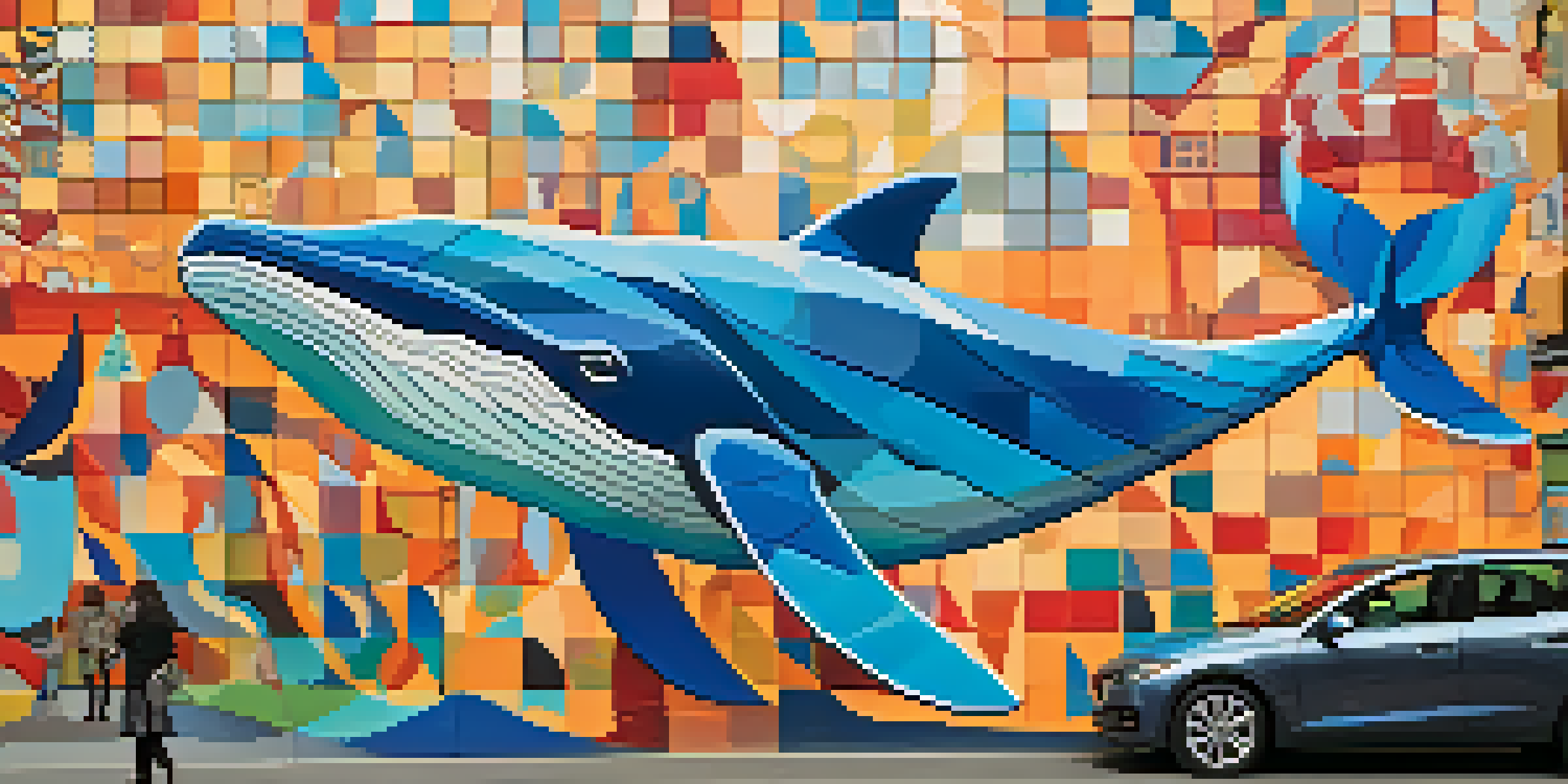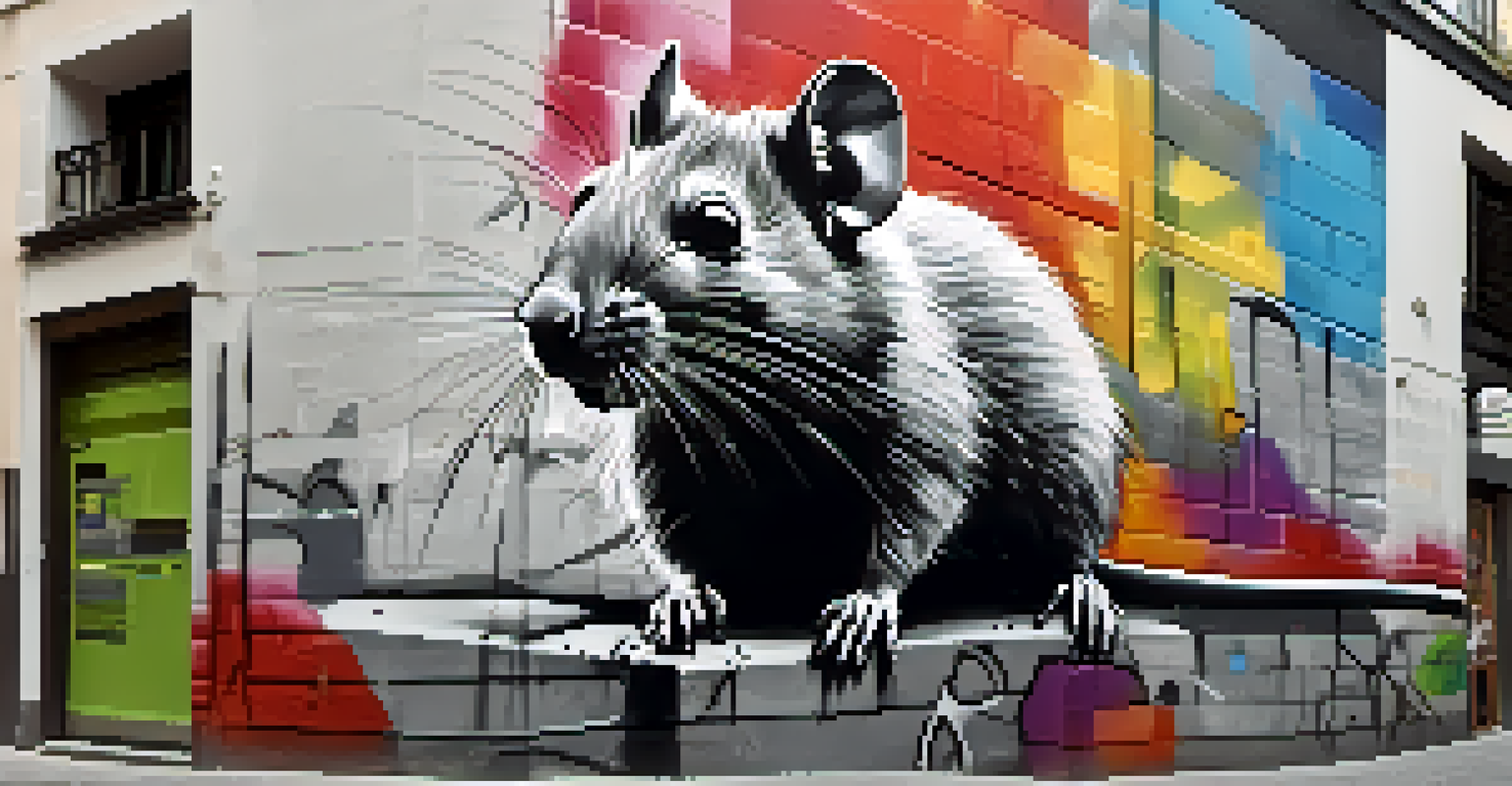Spain's Most Iconic Street Artists and Their Impact

The Rise of Street Art in Spain: A Cultural Movement
Street art in Spain has evolved into a dynamic cultural movement, reflecting the nation's rich history and diverse communities. Originally seen as a form of vandalism, it has gained recognition as a legitimate art form that expresses social and political messages. This transformation began in the late 20th century, particularly after the end of Franco's dictatorship, when artists sought new ways to voice their thoughts and emotions.
Art is a reflection of society, and street art is the voice of the people.
Cities like Barcelona and Madrid became canvases for artists, turning urban spaces into vibrant galleries. The explosion of creativity was fueled by a desire for freedom of expression, leading to the emergence of various styles and techniques. As more artists took to the streets, they not only beautified their surroundings but also engaged the public in meaningful dialogues about contemporary issues.
Today, street art in Spain is celebrated for its ability to challenge norms and inspire change. From bold murals to intricate stencils, each piece tells a story that resonates with the local culture. This movement has become a significant part of Spain's artistic identity, attracting tourists and art enthusiasts from around the world.
Blu: The Mysterious Maestro of Large-Scale Murals
Blu, an enigmatic figure in the street art scene, is known for his large-scale murals that often carry powerful political messages. His work critiques consumerism, war, and environmental issues, encouraging viewers to reflect on the state of the world. Blu's style is characterized by vivid colors and surreal imagery, making his murals instantly recognizable.

One of his most famous works, a mural in Bologna, depicts a giant blue whale being harpooned, a poignant commentary on humanity's impact on nature. This piece, like many of his others, invites viewers to engage with pressing social concerns. However, Blu has also been known to paint over his own works, leaving a sense of impermanence that mirrors the fleeting nature of social issues.
Street Art: A Cultural Movement
Street art in Spain has transformed from a perceived act of vandalism into a celebrated cultural movement that expresses social and political messages.
His murals can be found in various cities, including Barcelona and Madrid, where they add depth to the urban landscape. Blu's ability to blend art with activism has inspired a new generation of street artists, proving that art can be a powerful tool for change.
Okuda San Miguel: A Colorful Vision of Geometry and Nature
Okuda San Miguel is celebrated for his unique fusion of geometric patterns and vibrant colors, often inspired by nature and spirituality. His trademark style features a kaleidoscope of shapes that transform mundane urban spaces into visually striking experiences. Okuda's work resonates with themes of freedom, love, and harmony, inviting viewers to connect with their surroundings.
Street art is a way to engage the public in a dialogue about social issues and encourage change.
One notable project is his collaboration with the Spanish government to revitalize abandoned buildings through art. By transforming these spaces, he not only beautified the environment but also fostered community engagement and pride. Okuda's murals often feature animals, which symbolize a deep respect for nature and the interconnectedness of all living things.
Through his art, Okuda encourages a sense of wonder and introspection. His contributions to street art have made him a prominent figure in Spain and beyond, showcasing how creativity can breathe new life into neglected areas.
Roa: The Poetic Realism of Urban Wildlife
Roa, a Belgian street artist, has made a significant mark on Spain's urban landscape with his captivating depictions of animals. His work often highlights the beauty and fragility of wildlife, serving as a poignant reminder of the natural world in an urbanized setting. Roa's signature black-and-white style is both striking and thought-provoking, drawing viewers into a narrative that blends realism with a touch of surrealism.
One of his most memorable pieces features a giant rat, a nod to the often-overlooked creatures that inhabit our cities. By placing these animals in prominent public spaces, Roa challenges perceptions and invites discussions about the coexistence of urban life and nature. His art serves as a metaphor for resilience and adaptability in the face of adversity.
Artists Inspire Change Through Art
Figures like Blu and Okuda San Miguel use their murals to engage communities and inspire dialogue about pressing social and environmental issues.
Roa's work has inspired other artists to explore similar themes, contributing to a broader conversation about environmental awareness. His murals, scattered across cities like Madrid and Barcelona, remind us of the beauty that exists even in the most unexpected places.
Marta Minujín: The Playful Pioneer of Interactive Art
Marta Minujín is a pioneering Argentine artist whose playful approach to public art has captivated audiences in Spain and beyond. Known for her interactive installations and vibrant use of color, Minujín often invites viewers to engage with her work in unexpected ways. Her art blurs the line between viewer and participant, creating a sense of community around her installations.
One of her most famous projects is the 'Parthenon of Books,' an installation made entirely of banned books, symbolizing freedom of expression. This piece, exhibited in various locations, sparked conversations about censorship and the power of literature. Minujín's ability to address serious themes through playful art sets her apart in the contemporary art scene.
Her works often reflect her belief in the transformative power of art to inspire joy and provoke thought. By encouraging interaction, Minujín creates shared experiences that resonate far beyond the canvas, fostering a deeper connection between art and society.
The Impact of Street Art on Local Communities in Spain
Street art has a profound impact on local communities in Spain, transforming neglected spaces into vibrant cultural hubs. Murals and installations not only beautify urban areas but also serve as a source of pride and identity for residents. This revitalization often leads to increased tourism, as visitors flock to see the unique artwork that defines each neighborhood.
Moreover, street art fosters a sense of community engagement, as local artists collaborate with residents to create public art projects. These initiatives often address social issues relevant to the community, sparking conversations and promoting activism. In essence, street art becomes a medium for storytelling, allowing communities to express their values and aspirations.
Challenges and Future of Street Art
Despite facing legal and commercial challenges, Spain's street artists remain resilient, paving the way for a vibrant future in artistic expression.
The positive changes brought about by street art can be seen in various cities across Spain, where public spaces once considered drab have been transformed into lively galleries. This movement not only enhances the aesthetic appeal of neighborhoods but also strengthens community bonds, showcasing the power of art to unite people.
Challenges Facing Spain's Street Artists Today
Despite the growing recognition of street art as a legitimate form of expression, artists in Spain still face significant challenges. Legal issues surrounding public art can lead to fines and arrests, as many works are created without official permission. This precarious position often forces artists to navigate a complex landscape of regulations and community expectations.
Moreover, the commercialization of street art presents another hurdle. As cities seek to capitalize on the trend, there's a risk that the original intent of street art—challenging norms and expressing dissent—may be diluted. Artists must balance their artistic integrity with the demands of the market, often leading to difficult choices.

Despite these challenges, many street artists continue to push boundaries and find innovative ways to express their messages. They remain resilient, using their art to inspire change and engage with communities, proving that the spirit of street art is very much alive in Spain.
The Future of Street Art in Spain: A Bright Horizon
The future of street art in Spain looks promising, with a new generation of artists ready to take the helm. These emerging talents are experimenting with new techniques, mediums, and themes, reflecting the evolving culture and societal issues. As technology advances, we may also see a rise in digital street art, further expanding the possibilities for creative expression.
Moreover, the increasing acceptance of street art as a legitimate form of artistic expression is encouraging more collaborations between artists and local governments. Initiatives that promote public art projects can lead to more inclusive and diverse representations of communities. This shift signifies a growing recognition of the value that street art brings to urban environments.
As we look to the future, it's clear that street art will continue to play a vital role in shaping Spain's cultural landscape. With its ability to inspire, provoke thought, and unite communities, street art remains an essential part of Spain's identity, ready to evolve and thrive in the years to come.